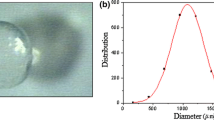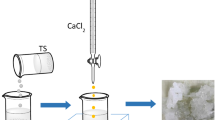Abstract
Binding of heavy metal ions by calcium alginate has been described in the literature with many different models. In the present study, two most basic models were used to systematically compare their simultaneous description of metal uptake dependence on pH and metal ion concentration in the bulk solution. The experimental datasets corresponding to the binary sorption systems containing protons and heavy metal ion (cadmium, lead, or copper) were taken from the literature. The applicability and limitations of both models are discussed. Neither of the models gave a completely satisfactory description of all data. The two-site occupancy model yielded better results compared to the one-site occupancy model when considering the coherence of the parameters (e.g., affinity constants) but the quality of the obtained fits is similar in both cases.




Similar content being viewed by others
References
Arica MY, Kaçar Y, Genç O (2001) Entrapment of white-rot fungus Trametes versicolor in Ca-alginate beads: preparation and biosorption kinetic analysis for cadmium removal from an aqueous solution. Bioresour Technol 80:121–129
Arica MY, Arpa C, Ergenea A, Bayramoglu G, Genç O (2003) Ca-alginate as a support for Pb(II) and Zn(II) biosorption with immobilized Phanerochaete chrysosporium. Carbohydr Polym 52:167–174
Arica MY, Bayramoglu G, Yilmaz M, Bektaş S, Genç O (2004) Biosorption of Hg2+, Cd2+, and Zn2+ by Ca-alginate and immobilized wood-rotting fungus Funalia trogii. J Hazard Mater 109:191–199
Bayramoğlu G, Arica MY (2009) Construction a hybrid biosorbent using Scenedesmus quadricauda and Ca-alginate for biosorption of Cu(II), Zn(II) and Ni(II): kinetics and equilibrium studies. Bioresour Technol 100:186–193
Braccini I, Pérez S (2001) Molecular basis of Ca2+-induced gelation in alginates and pectins: the egg-box model revisited. Biomacromolecules 2:1089–1096
Crist RH, Martin JR, Carr D, Watson JR, Clarke HJ, Crist DR (1994) Interaction of metals and protons with algae. 4. Ion exchange vs adsorption models and a reassessment of Scatchard plots; ion-exchange rates and equilibria compared with calcium alginate. Environ Sci Technol 28:1859–1866
Davis TA, Volesky B, Mucci A (2003) A review of the biochemistry of heavy metal biosorption by brown algae. Water Res 37:4311–4330
Davis TA, Pinheiro JP, Grasdalen H, Smidsrød O, van Leeuwen HP (2008) Stability of lead(II) complexes of alginate oligomers. Environ Sci Technol 42:1673–1679
Drury J, Mooney D (2003) Hydrogels for tissue engineering: scaffold design variables and applications. Biomaterials 24:4337–4351
Febrianto J, Kosasih AN, Sunarso J, Ju Y-H, Indraswati N, Ismadji S (2009) Equilibrium and kinetic studies in adsorption of heavy metals using biosorbent: a summary of recent studies. J Hazard Mater 162:616–645
Fein JB, Martin AM, Wightman PG (2001) Metal adsorption onto bacterial surfaces: development of a predictive approach. Geochim Cosmochim Acta 65:4267–4273
Fourest E, Volesky B (1997) Alginate properties and heavy metal biosorption by marine algae. Appl Biochem Biotechnol 67:215–226
Fuks L, Filipiuk D, Majdan M (2006) Transition metal complexes with alginate biosorbent. J Mol Struct 792–793:104–109
Grant G, Morris E, Rees D, Smith P, Thom D (1973) Biological interactions between polysaccharides and divalent cations: the egg-box model. FEBS Lett 32:195–198
Haug A (1961) The affinity of some divalent metals to different types of alginates. Acta Chem Scand 15:1794–1795
Khotimchenko M, Kovalev V, Khotimchenko Y (2008) Comparative equilibrium studies of sorption of Pb(II) ions by sodium and calcium alginate. J Environ Sci 20:827–831
Kikuchi A, Okano T (2002) Pulsatile drug release control using hydrogels. Adv Drug Deliv Rev 54:53–77
Li Y, Liu F, Xia B, Du Q, Zhang P, Wang D, Wang Z, Xia Y (2010) Removal of copper from aqueous solution by carbon nanotube/calcium alginate composites. J Hazard Mater 177:876–880
Lim S-F, Zheng Y-M, Zou S-W, Chen JP (2008) Characterization of copper adsorption onto an alginate encapsulated magnetic sorbent by a combined FT-IR, XPS, and mathematical modeling study. Environ Sci Technol 42:2551–2556
Lu L, Liu X, Qian L, Tong Z (2003) Sol–gel transition in aqueous alginate solutions induced by cupric cations observed with viscoelasticity. Polymer J 35:804–809
Martinsen A, Skjak-Braek G, Smidsrod O (1989) Alginate as immobilization material: I. Correlation between chemical and physical properties of alginate gel beads. Biotechnol Bioeng 33:79–89
Papageorgiou S, Katsaros F, Kouvelos E, Nolan J, Le Deit H, Kanellopoulos N (2006) Heavy metal sorption by calcium alginate beads from Laminaria digitata. J Hazard Mater 137:1765–1772
Papageorgiou S, Kouvelos E, Favvas E, Sapalidis A, Romanos G, Katsaros F (2010) Spectroscopy. Carbohydr Res 345:469–473
Plazinski W, Rudzinski W (2009) Modeling the effect of surface heterogeneity in equilibrium of heavy metal ion biosorption by using the ion exchange model. Environ Sci Technol 43:7465–7471
Plazinski W, Rudzinski W (2010a) Binding stoichiometry in sorption of divalent metal ions: a theoretical analysis based on the ion-exchange model. J Colloid Interface Sci 344:156–170
Plazinski W, Rudzinski W (2010b) How does mechanism of biosorption determine the differences between the initial and equilibrium adsorption states? Adsorption 16:351–357
Schiewer S, Patil SB (2008) Modeling the effect of pH on biosorption of heavy metals by citrus peels. J Hazard Mater 157:8–17
Schiewer S, Volesky B (1997) Ionic strength and electrostatic effects in biosorption of divalent metal ions and protons. Environ Sci Technol 31:2478–2485
Stumm W, Morgan JJ (1996) Aquatic chemistry: chemical equilibria and rates in natural waters. Wiley, New York
Veglió F, Esposito A, Reverberi AP (2002) Copper adsorption on calcium alginate beads: equilibrium pH-related models. Hydrometallurgy 65:43–57
Acknowledgments
The author acknowledges the financial supports of the Foundation for Polish Science (START program, 2010) and of the Polish Ministry of Science and Higher Education (contract financed in 2010–2012 under project no. N N204 271238).
Author information
Authors and Affiliations
Corresponding author
Additional information
Responsible editor: Elena Maestri
Appendix
Appendix
Let us consider the reaction of calcium ions binding by alginate and the corresponding equilibrium constant:
This reaction, combining with Eqs. (1), (2), (3), and (4), describes the ternary system, containing heavy metal ions, calcium ions and protons. Each of these species can be present both in the bulk solution and in the complex with alginate (bound). The two-site occupancy mechanism of calcium binding is justified in the context of “egg-box” model describing the interactions between Ca2+ ions and alginate chains (Braccini and Pérez 2001; Grant et al. 1973). Equation (A1) can be combined with Eqs. (1), (2), (3), and (4) and the modified mass–balance relation (now, the presence of bound calcium ions must be included) in order to obtain the mathematical expressions describing the heavy metal (q Me) and calcium (q Ca) uptakes in the function of pH. The exact form of mathematical description (for 2-SO model) is given by the following system of Eqs. (A2) and (A3):
Some part of the results is presented in Fig. 5. It appeared that the influence of Ca2+ ions on the pH-dependent binding of heavy metals can be (mathematically precisely) described in terms of the r = (K Me C)/(K Ca C Ca) ratio, where K can be either K M,1 or K M,2, depending on the accepted model. When r > 10, the presence of calcium ions does not play a significant role and the system can be treated as a binary one, i.e., only the presence of protons and heavy metal ions should be taken into account. The metals considered in this study (Cu, Pb, Cd) have much higher affinity to alginates in comparison to calcium, according to numerous experimental studies (see, for instance, Haug (1961) and Lim et al. (2008)). Thus, K Ca can be assumed to be at least of an order of magnitude lower than K (the exact value depends on the considered system). The value of the respective concentrations ratio is harder to estimate but in most of the systems the inequality C Ca < C Me is fulfilled (see for instance the data by Khotimchenko et al. (2008)). Thus, the limit of the r > 10 condition corresponds approximately to calcium ion concentration equal to C Me and from Fig. 5 follows that the presence of calcium ions can be neglected only when the value of the (K Me C)/(K Ca C Ca) ratio exceeds (approximately) 10. The values of pK a and N s are not significant for the aforementioned effect.
The q Me/N s and q Ca/N s values plotted in the function of (pH–pK a ) for several values of K Ca C Ca parameter and for the 2-SO model. The fixed value K Me C = 104 g/mol was accepted; the unit of K Ca C Ca is gram per mole. Analogical results can be obtained for the 1-SO model and for other values of K Me C
Rights and permissions
About this article
Cite this article
Plazinski, W. Sorption of lead, copper, and cadmium by calcium alginate. Metal binding stoichiometry and the pH effect. Environ Sci Pollut Res 19, 3516–3524 (2012). https://doi.org/10.1007/s11356-012-0913-1
Received:
Accepted:
Published:
Issue Date:
DOI: https://doi.org/10.1007/s11356-012-0913-1





